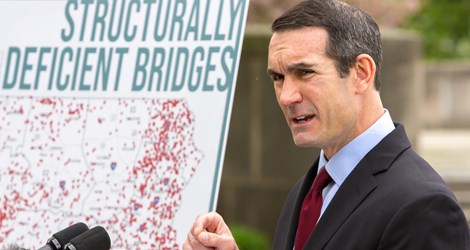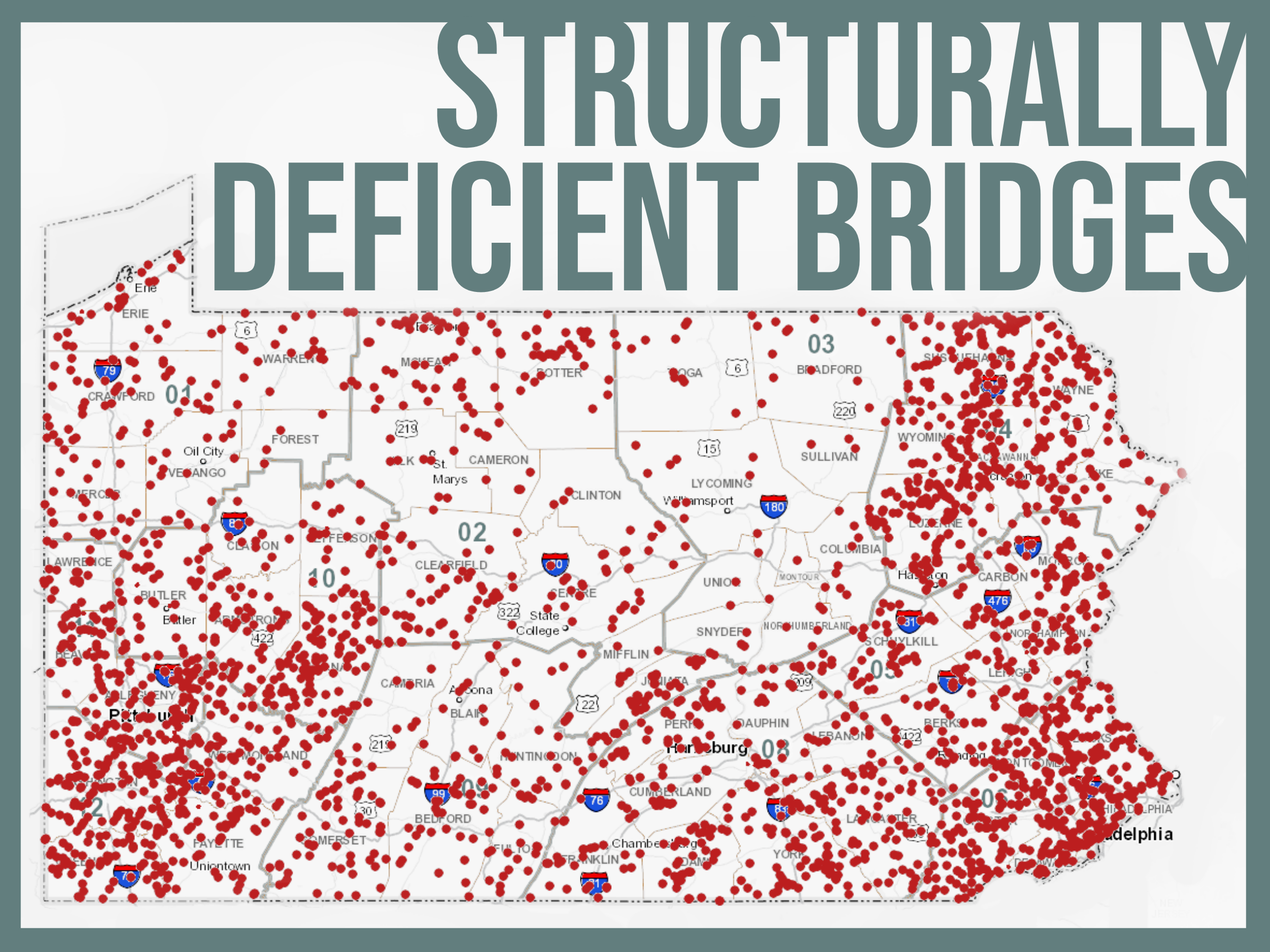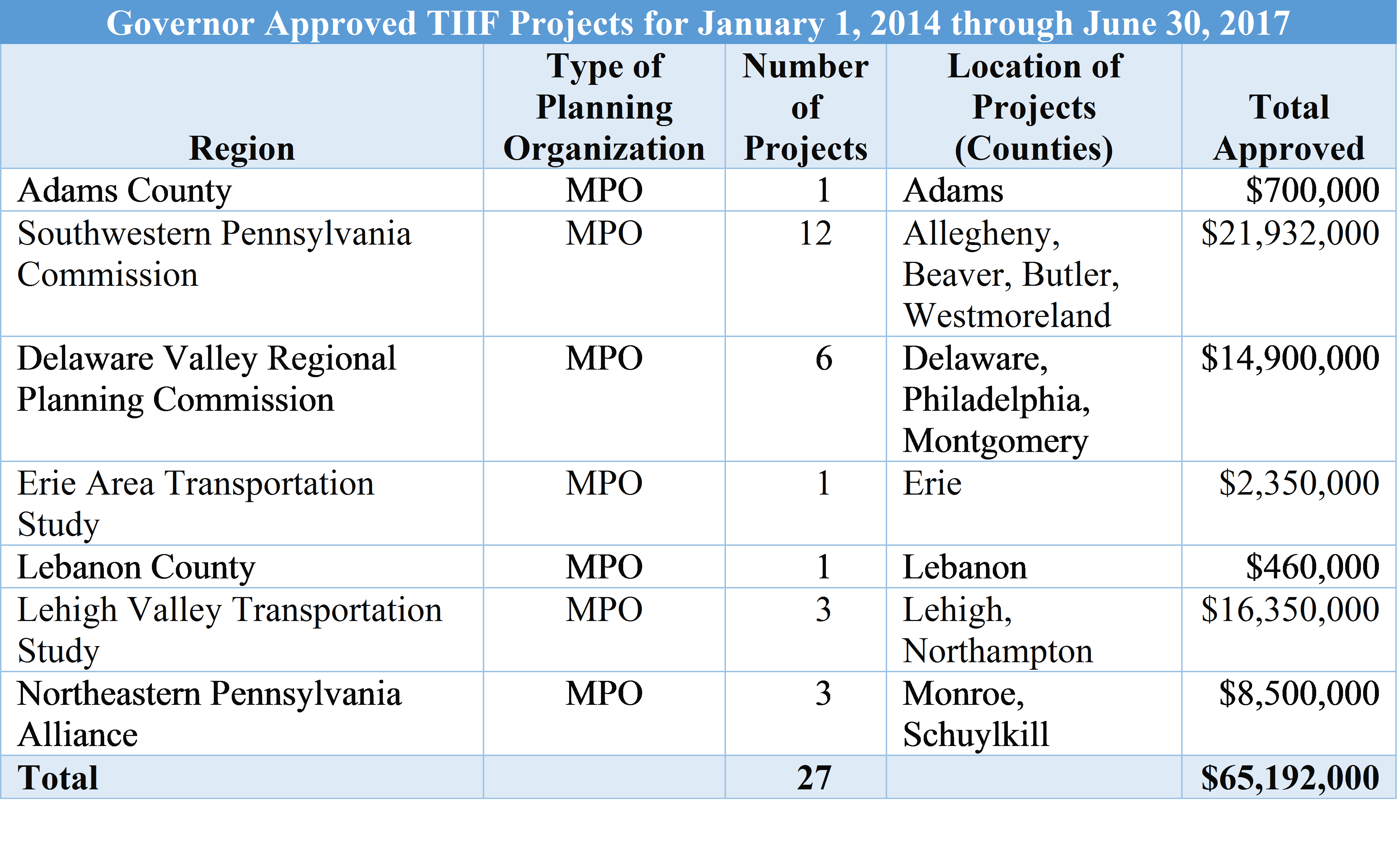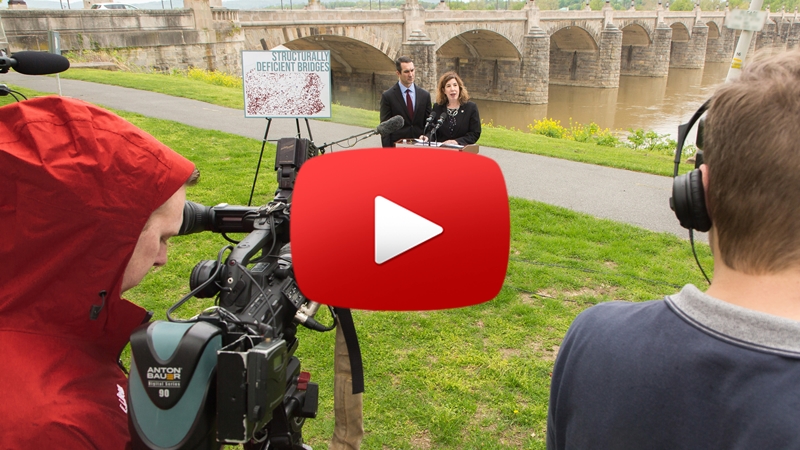Auditor General DePasquale: PennDOT Audit Finds $4.2 Billion Diverted from Repairing Roads, Bridges
Funding could have helped eliminate list of 2,829 structurally deficient bridges
Auditor General DePasquale: PennDOT Audit Finds $4.2 Billion Diverted from Repairing Roads, Bridges
Funding could have helped eliminate list of 2,829 structurally deficient bridges
HARRISBURG (April 25, 2019) – Auditor General Eugene DePasquale today said his new audit of the Pennsylvania Department of Transportation (PennDOT) shows the agency could be further along in repairing rough highways and fixing 2,829 structurally deficient bridges with the billions of dollars it has been forced to pay to State Police.
DePasquale noted that transfers from the Motor License Fund to State Police have totaled more than $4.25 billion since the 2012-13 fiscal year, money that PennDOT could otherwise have used to address a growing list of needed repairs across the state.
“More than 2,800 state-maintained bridges across Pennsylvania are structurally deficient and our bridges average over 50 years in age – beyond what they were designed to last,” DePasquale said. “That $4.25 billion could have cut that list in half and if PennDOT could use all of the gas tax money for roads and bridges we could get that number to zero in about 5 years.”
Under the state Constitution, proceeds from the Motor License Fund are to be used solely for the construction, reconstruction, maintenance and repair of and safety on public highways and bridges.
“There’s a whopping 57.6 cents of state tax added to each gallon of gas sold in Pennsylvania,” DePasquale said, noting that adds $5.76 to the cost of every 10 gallons of gas put in the tank. “Pennsylvanians are frustrated that our roads and bridges still need so much help at the same time we are paying the highest gas tax in the United States.”
The General Assembly did act to phase in a cap on the amount of money going to State Police from the Motor License Fund. In the 2017-18 fiscal year, State Police received $789,580,000 from the fund.
“The nearly $800 million that came out of the fund in one year could have helped PennDOT make a significant dent in the list of urgent needs across Pennsylvania,” he added. “While State Police certainly deserve to be adequately funded, I don’t think anyone is thrilled about seeing gas tax revenues being siphoned off for purposes other than improving our roads and bridges.”
DePasquale applauded PennDOT for its aggressive efforts to address the list of structurally deficient bridges, which peaked at 6,034 in 2008. He spoke near Harrisburg’s Market Street Bridge, the western span of which is rated as structurally deficient and carries approximately 13,000 vehicles per day. The bridge was built in 1928.
The audit also examined how funds are awarded through the Transportation Infrastructure Investment Fund (TIIF), which PennDOT administers with the help of the Department of Community and Economic Development. Funds are awarded at the governor’s discretion for transportation projects associated with economic development opportunities.
During the audit period, between Jan. 1, 2014, and June 30, 2017, PennDOT indicated the governor approved TIIF monies for 27 projects totaling almost $65.2 million as follows:
“While these may have been very worthwhile projects, my audit team was unable to find detailed documentation explaining how and why they were selected to receive funding,” DePasquale said. “I recommend that this program be revised to work like a competitive grant program and steps should be taken to ensure all regions of the state have an equal chance to receive funds.”
The audit also recommends that PennDOT speed up the grant cycle for funds awarded through the Multimodal Transportation Fund, which was created to help communities pay for projects that promote pedestrian safety and transit revitalization. DePasquale said making such a change would add more transparency to the grant process and eliminate confusion about how much grant money is available.
In addition, the audit said PennDOT’s purchasing card process is generally in compliance with the state’s procurement code but recommends the agency continue to improve its internal controls to minimize errors and mitigate the risks of fraud or abuse.
“I want to commend PennDOT for tightening up its internal controls, which are significantly better than they were in decades past,” DePasquale added.
Visit www.paauditor.gov to review the performance audit for the Pennsylvania Department of Transportation or learn more about the Department of the Auditor General.
# # #
Editor’s Note: With the nearly $800 million transferred from the Motor License Fund to State Police in 2017-18, PennDOT could accelerate or commit funding to some of the following important projects in various regions of the state:
Oil-City based region
The district currently has a project to reconstruct 15 miles of Interstate 80 from the Ohio line to Route 19 in Mercer County slated to start in February 2023. The estimated $146 million project would be a high priority to accelerate if additional funds were available because PennDOT is currently conducting emergency concrete patching in this area due to pavement conditions.
The department is reviewing the extent of work necessary to rehabilitate a bridge carrying Interstate 79 over the CSX railroad and to reconstruct half a mile of pavement from the bridge to the Bayfront Parkway in Erie. The project is unfunded, but preliminary estimates put potential needs at approximately $20 million total.
Clearfield-based region
With additional funding, PennDOT could expedite design and begin construction on a project to resurface and complete Intelligent Transportation System improvements on Interstate 80 in eastern Clearfield County. The project would cover 17 miles and is estimated at roughly $25 million.
Montoursville-based region
In the summer of 2020, PennDOT plans to patch the bridge deck of the Route 287 bridge over the Tioga River near Tioga Borough in Tioga County for up to $20,000. With additional funds, PennDOT could instead replace the bridge deck starting in 2019 for roughly $3.8 million.
Dunmore-based region
PennDOT estimates it could replace 11 bridges in Pike, Susquehanna, Lackawanna, and Wayne counties in 2026 or 2027 if roughly $17.8 million is identified. With additional funding, projects could begin or accelerate design now with a goal of starting construction in 2022.
With additional funding, a project to preserve four bridges carrying Interstate 84 in Lackawanna County that is slated for fall 2020 could become a project to replace those four bridges starting in 2023.
Allentown-based region
With additional funding, PennDOT could speed up rehabilitation of 2.6 miles of Route 611 in the Delaware Water Gap National Recreation Area, Monroe County that has been identified as the “missing link” connector for the Liberty Trail. The $30 million project is not set to begin preliminary engineering work until 2024.
Philadelphia region
With additional funds, the department would conduct surface treatment on high-traffic, non-limited access highways within the five-county region within four years. This work is currently unfunded and would require approximately $250 million.
Harrisburg region
With its western span being rated as structurally deficient, work on the Market Street Bridge is in a holding pattern while PennDOT studies how best to address it and other nearby bridges that cross the Susquehanna River. The availability of additional funding could accelerate that needed work.
Hollidaysburg-based region
There are six bridges over U.S. Route 22 in Cambria County that need work to address under-clearance issues and general preservation. Currently, the earliest that work could begin would be in 2028, and the estimated $13 million project does not have funding identified.
PennDOT Districts 11 and 12 (seven southwestern counties)
In these seven counties alone, PennDOT is aware of 373 landslides of varying severity. The cost to repair all of these would be $167 million. However, PennDOT currently can only plan to repair 30 of them for an estimated $27 million.



